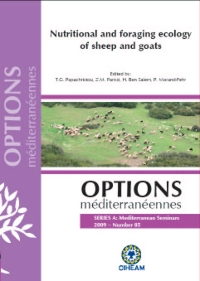| Article précédent | p. 49-54 | Article suivant |
Impact of animal sheds on vegetation configuration in Mediterranean landscapes
Animal sheds function as oikospheres, namely focal points, in Mediterranean landscapes. This is because livestock tend to spend more time grazing near them rather than away from them. Consequently, vegetation is impacted differently around animal sheds resulting in the creation of distinct patches. This impact was investigated in a grazed landscape located in Lagadas county, northern Greece. The dominant vegetation type was kermes oak (Quercus coccifera L.) shrublands. Out of a total of 60 sheds found in an area of 150 km2, three representative sheds housing goats or sheep were selected. Two line transects 800 m long each were placed on each shed in opposite directions and plots of 30 x 30 m were identified at distances 0, 50, 100, 200 and 800 m away from the sheds. Within each plot, plant height and ground cover of the various plant functional types were measured. Plant height and cover of the woody species increased as the distance from the sheds increased (P < 0.0064 and P < 0.0193, respectively) while the cover of herbaceous species, both annual and perennial, decreased (P < 0.0320 and P < 0.0049, respectively). The results indicate that animal sheds are a means of opening up dense shrublands by favoring short vegetation (mainly herbaceous) and thus creating a heterogeneous landscape with a high variety of habitats very resistant to wildfires, a major threat to Mediterranean ecosystems.
Les abris fonctionnent comme des oikosphères, c'est-à-dire des points centraux, dans les paysages méditerranéens. Ceci s'explique par le fait que le bétail a tendance à passer plus de temps près des abris. En conséquence, la végétation à proximité de ces abris subit plus de pression que celle loin de ces refuges. Il en résulte la création de milieux distincts. Cet impact a été étudié dans un paysage pâturé situé dans la province de Lagadas, au nord de la Grèce. Le type de végétation dominant était la garrigue à chêne kermès (Quercus coccifera L.). A partir de 60 abris dans une surface de 150 km2, trois abris représentatifs occupés par des chèvres et des moutons ont été sélectionnés. Deux transects linéaires, de 800 m de long chacun, ont été placés au niveau de chaque abri dans des directions opposées, et des parcelles de 30 x 30 m situées à 0, 50, 100, 200 et 800 m des abris ont été utilisées. Dans chaque parcelle, la hauteur des plantes et la couverture du sol par les différents types fonctionnels ont été mesurées. Cette étude a montré que la hauteur des plantes et la couverture d'espèces ligneuses augmentent en fonction de l'éloignement par rapport aux abris (P < 0,0064 et P < 0,0193 respectivement) tandis que la couverture des espèces herbacées, annuelles et vivaces, diminue (P < 0,0320 et P < 0,0049 respectivement). Les résultats indiquent que les abris sont une voie d'ouverture et par conséquent d'exploitation efficace des garrigues denses en favorisant le développement d'une végétation basse (principalement herbacée). Cela permet la création d'un paysage hétérogène avec une diversification importante des habitats résistant bien aux incendies qui constituent une menace sérieuse pour les écosystèmes méditerranéens.
- [ Afficher ]
- [ Télécharger ]
- [ Exporter la citation ]
Vous pouvez télécharger la citation au format :
- [ Imprimer ]
-
Mots-clés
CAPRIN, COUVERTURE VEGETALE, GRECE, OVIN, PAYSAGE, SCRUBCiter cet article
Papanastasis V.P., Ghossoub R., Scarpelo C. Impact of animal sheds on vegetation configuration in Mediterranean landscapes. In : Papachristou T.G. (ed.), Parissi Z.M. (ed.), Ben Salem H. (ed.), Morand-Fehr P. (ed.). Nutritional and foraging ecology of sheep and goats. Zaragoza : CIHEAM / FAO / NAGREF, 2009. p. 49-54. (Options Méditerranéennes : Série A. Séminaires Méditerranéens; n. 85). 12. Seminar on: Nutritional and Foraging Ecology of Sheep and Goats, 2007/10/11-13, Thessaloniki (Greece). http://om.ciheam.org/om/pdf/a85/00800983.pdf



